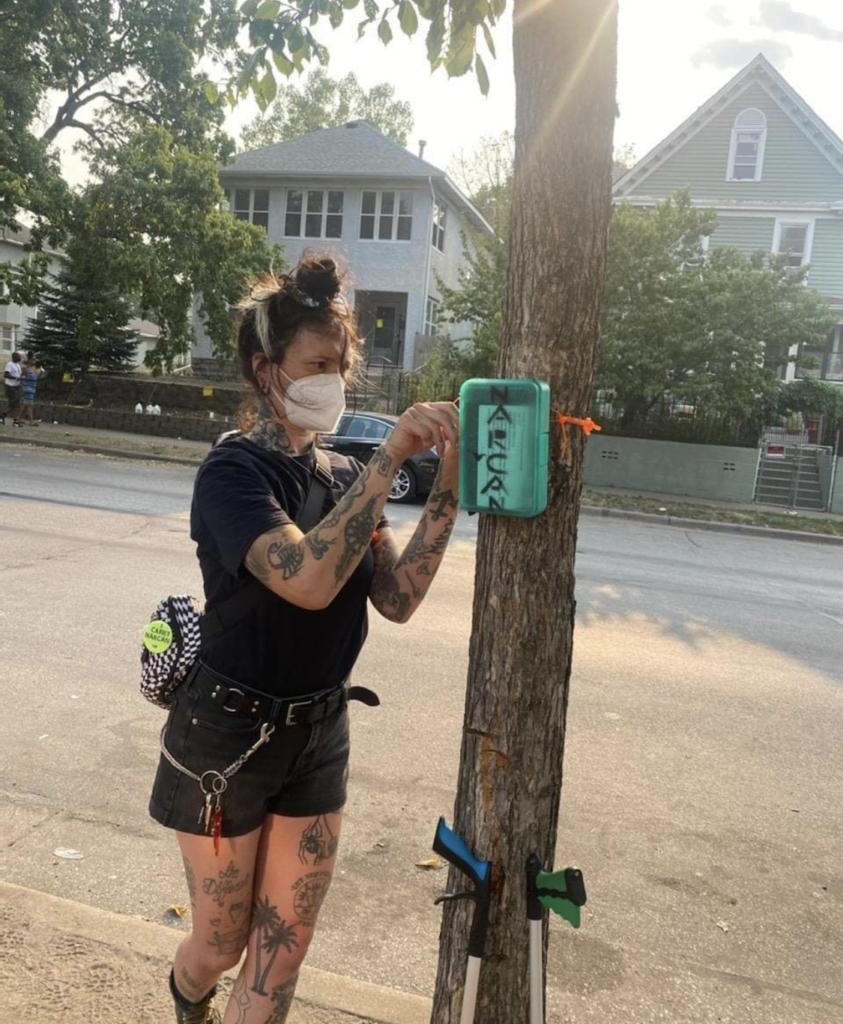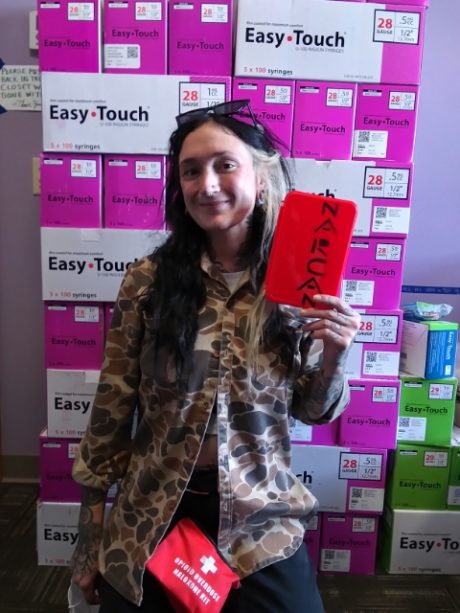By TINA MONJE
Despite spiking overdose deaths, the nation’s grassroots harm reduction organizations were notified this spring that Pfizer, their primary supplier of affordable, single-dose injectable naloxone (i.e. Narcan), would temporarily halt production. Pfizer has declined to provide information with major news sources, except that this halt has nothing to do with COVID-19 vaccines, and that production will resume in February.

Of the many naloxone producers, Pfizer is the only one who sells the product at an affordable rate. In 2012, the company entered into an agreement with a nation-wide buyers club consisting of community harm reduction organizations in an effort to get the opioid overdose reversal drug into the hands of those most likely to respond to overdose – people who use drugs (PWUD).
Minneapolis-based Southside Harm Reduction Services (SHRS) is one of the many buyers club members who rely on Pfizer’s accessibility. Of the syringe services programs (SSPs) in Minnesota, SHRS purchases and distributes the largest quantity. SHRS Founder and Executive Director Jack Martin reports that, between June 2020 and 2021 alone, they distributed at least 80,000 doses to PWUD either directly, or through other SSPs, organizations, and individuals.
While naloxone is theoretically abundant, a single dose from other producers can run about $20 each, an infeasible price for PWUD, and for the underfunded or underground entities who serve them.
“There’s enough naloxone in the world,” says Martin.” We don’t need to be in a situation where we’re having to deny people naloxone.” Martin suggests that other pharmaceutical companies either cannot or simply will not offer it at competitive prices. For now, SHRS is relying on donations from other generous organizations.
This avoidable crisis comes during a time when PWUD need naloxone more frequently and in larger quantities. During 2020, the nation saw its highest death rate from opioid overdose. In the Twin Cities metro area, reported overdoses increased by more than 30%. Minnesota has some of the highest overdose race rate disparities in the country. Indigenous people are at least seven times more likely to die of overdose, and African Americans at least two times more likely, than their white peers.
SHRS Linkage to Care Coordinator Marissa Bonnie says it’s taking more doses to reverse overdoses due to fentanyl, an unregulated opioid that is notably many times stronger than pure heroin. While some people choose to use fentanyl for its strength, many overdoses happen when people are unaware that their drugs contain this powerful filler of an opioid. This is not exclusive to heroin. Fentanyl has caused overdoses via mock prescription opioids, as well as drugs unrelated to opioids, notably methamphetamine, cocaine, and even MDMA or ecstasy.
That this life-saving drug has not been more accessible, even before this ostensible shortage, has contributed to countless and needless deaths. Referring to United States healthcare and structural racism, and highlighting how this shortage of medicine will affect communities of color at higher rates than white communities, Bonnie reminds us that systems fail people. If we don’t change these systems, we can’t survive crises like these.”
Shortage or not, opioid overdose is relevant to everyone, regardless of drug use or lack thereof, regardless of age, associations or social circles, and regardless of where and how one purchases their opiates or opioids. People who use intravenously are the most likely to respond to overdoses with the most frequency. Many people who work in healthcare or human services may also encounter overdoses at a higher rate than the average individual. But the truth is, anyone can encounter an overdose anytime, and anywhere.
“We might assume that overdoses only happen in certain contexts,” cautions Registered Nurse Nikki Giardina of Native American Community Clinic (NACC), but it can happen with prescribed medication, it can happen when taking a combination of drugs or medications, it can happen with mock prescriptions or opioids purchased on the internet, and it can even happen with recreational drugs that are not normally associated with heroin or fentanyl. It can happen at the park, the library, the bar, a coffee shop, on the bus, at the light rail station, at work, at weddings, or anyone else. You understand. Etcetera.
For this reason, it is key to remember three things: 1. Look for the signs of opioid overdose rather than the drug(s) you think someone took, 2. Giving naloxone to someone who is not, in fact, overdosing on opiates would almost never, ever do damage, and 3. You are capable of helping to reverse overdose when you see one. Now let’s dive into more detail about how you can be helpful.
Note that the information below is derived from training materials offered by SHRS, NACC, and the National Harm Reduction Coalition.
WHERE TO GET NALOXONE

The two most common routes of entry are intramuscular (IM) via syringe, and intranasal using a pre-loaded nasal spray. Local syringe exchanges are usually a great, low-barrier resource for free naloxone. However, anyone with health insurance (even private) can walk into a pharmacy and request a kit, with or without a prescription. Though the pharmacists may serve looks and attitude, they are required to dish over one intranasal naloxone kit, and they will be more likely to hand it over to people who do not present as a person who uses drugs daily. This is a good option for anyone with the privilege to access it.
STEPS TO REVERSING AN OVERDOSE
- Identify: Is the individual overdosing, or simply very high? There are a few initial signs to look out for from a distance, including a lack of consciousness, skin that is ashy grey, blue or purple, or if you hear slow, snore-like or gurgly breathing (i.e. the ‘death rattle’).
- Stimulate: Try to stimulate the individual. Say hello, say it loud, tap their knee or shoulder, shake an arm. If they do not respond, confidently use your knuckles to apply an up-and-down sternum rub. This technique is safe but highly uncomfortable and usually rouses anyone in a deep high. This is your final turning point. If they respond, they are likely okay for now, but keep an eye on them if you can. Do not administer naloxone, and do not call 9-1-1 unless it seems like they may be experiencing some other medical emergency. If they do not respond, proceed to next steps.
- Call 9-1-1: Explain that you need an ambulance because you are with someone who is not breathing or not responding. Unfortunately, drug-user stigma can even prevent people from receiving immediate, life-saving care that is free from judgement. There is generally no need to tell dispatch why the individual is not responsive. EMTs almost always have naloxone. Police officers do not always carry it.
- Administer naloxone, if you have it (proceed to step three if you do not have naloxone): Swiftly administer your naloxone. If it is intranasal, follow the provided instruction manual, which should straightforwardly say something like stick device up their nose and press on plunger. If it is intramuscular, prepare your syringe by drawing up the naloxone from the vial. Avoid air bubbles, per usual, but don’t fuss. This is going into a muscle, not a vein. Aim for the muscularly dense regions of the body such as the upper arm or thigh. Know that no amount of practice can prepare someone for their first reversal – you’ve got this.
- Rescue Breaths: Position the individual on their back, tip their head back and chin up in order to straighten the airway, pinch the nose, seal your mouth over theirs, and deliver one breath every five seconds. You are doing this properly when you see their chest rise with every breath you provide. Even if you do not have naloxone, you can still save the person’s life by providing oxygen. Giardina says that providing rescue breaths in and of itself isn’t doing anything to reverse what is happening – but it is buying you more time until emergency responders arrive by ensuring vital organs are receiving oxygen.
- Repeat Administration?: If the individual is still unresponsive three to five minutes after the first dose, and if an ambulance has still not arrived by this time, deliver another dose and continue rescue breaths. There is no known maximum of how many doses a body can take. Some overdoses require only one dose. Many will require more than one. Some may require upwards of ten.
WHAT IF IT DOES NOT WORK?
There may be a handful of reasons why naloxone did not work. It’s possible that the individual is actually not overdosing but is experiencing some other medical emergency. It’s possible their heart has already stopped, or that they still need one or a few more doses. Ideally, certified responders will have arrived before you need to determine any next steps.
WHAT IF IT WORKS?
Know that to be aroused from a deep high can be frightening and can even induce a sudden onset of withdrawal symptoms. While some people awake from overdose gently, others have been known to wake up panicked and/or experiencing withdrawal symptoms. Give them space, and if you can help it, continue to make sure they are safe. The lethal dose of opioids is still in their system waiting for the naloxone, which is acting as a barricade between the brain’s receptors and the lethal dose, to soon fade away.
Thank you for taking this extra neighborly step by carrying naloxone, even if you thought you didn’t need it. For questions and training, please contact NACC, SHRS, or visit the National Harm Reduction Coalition’s website.









